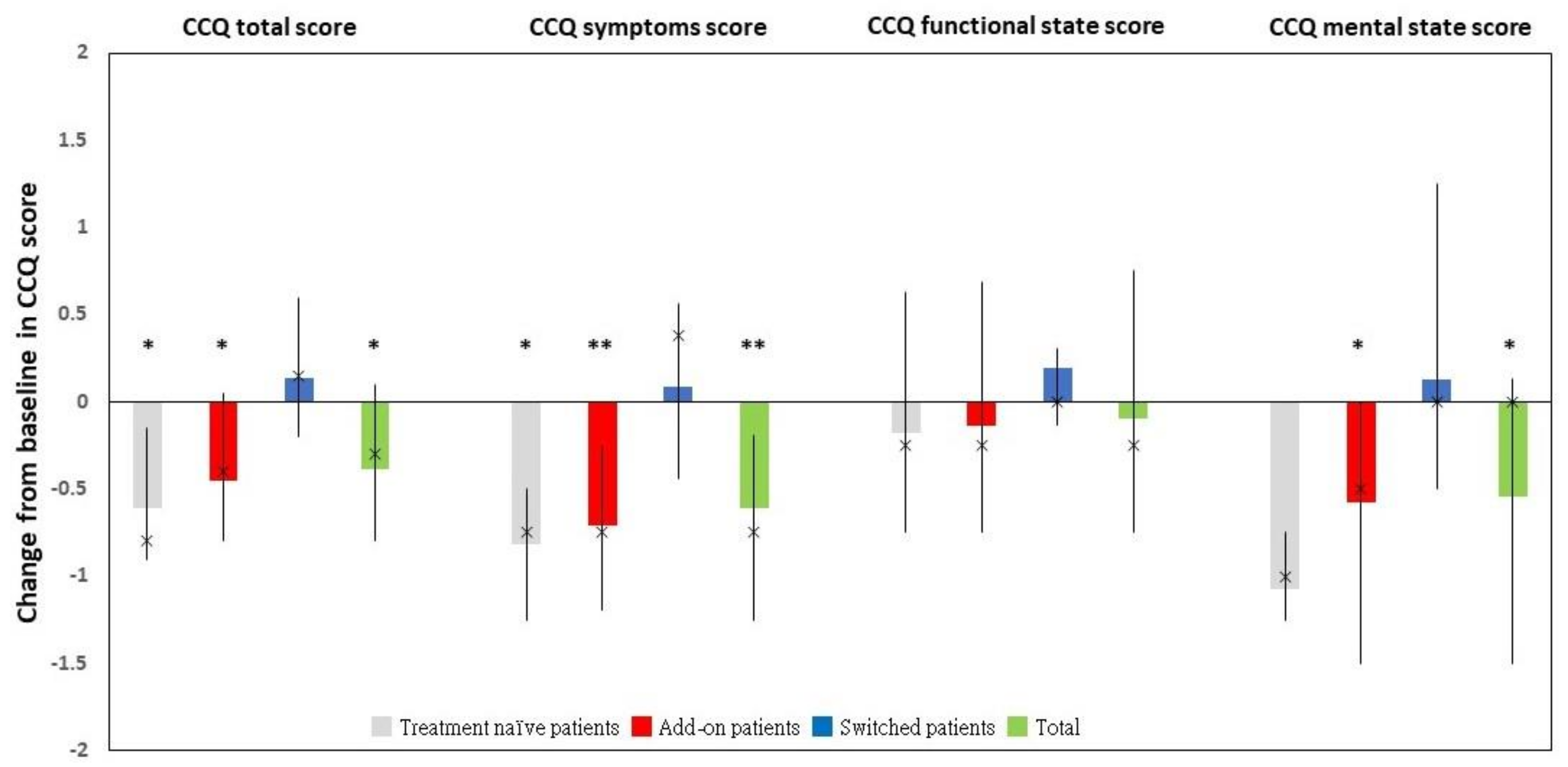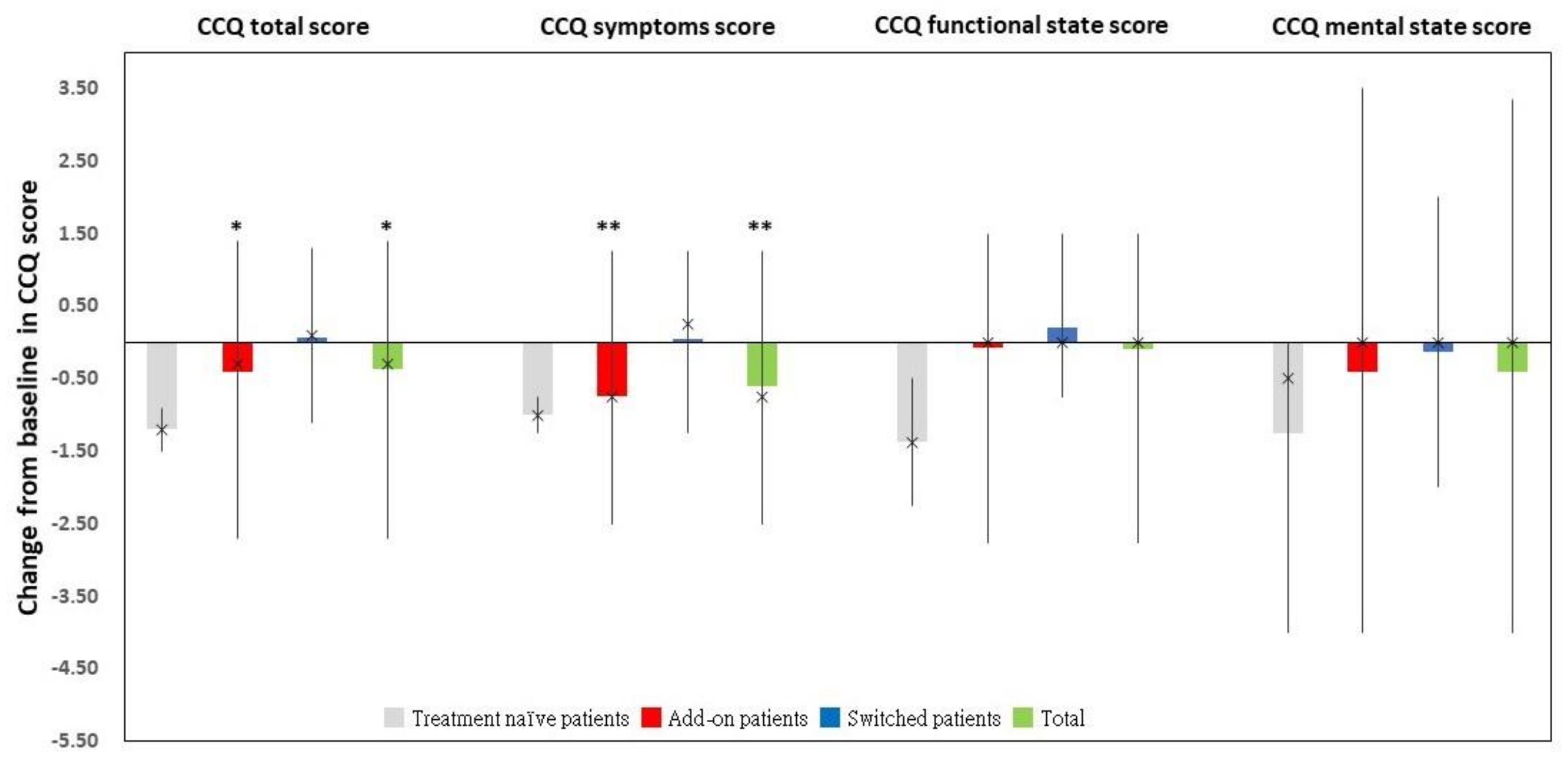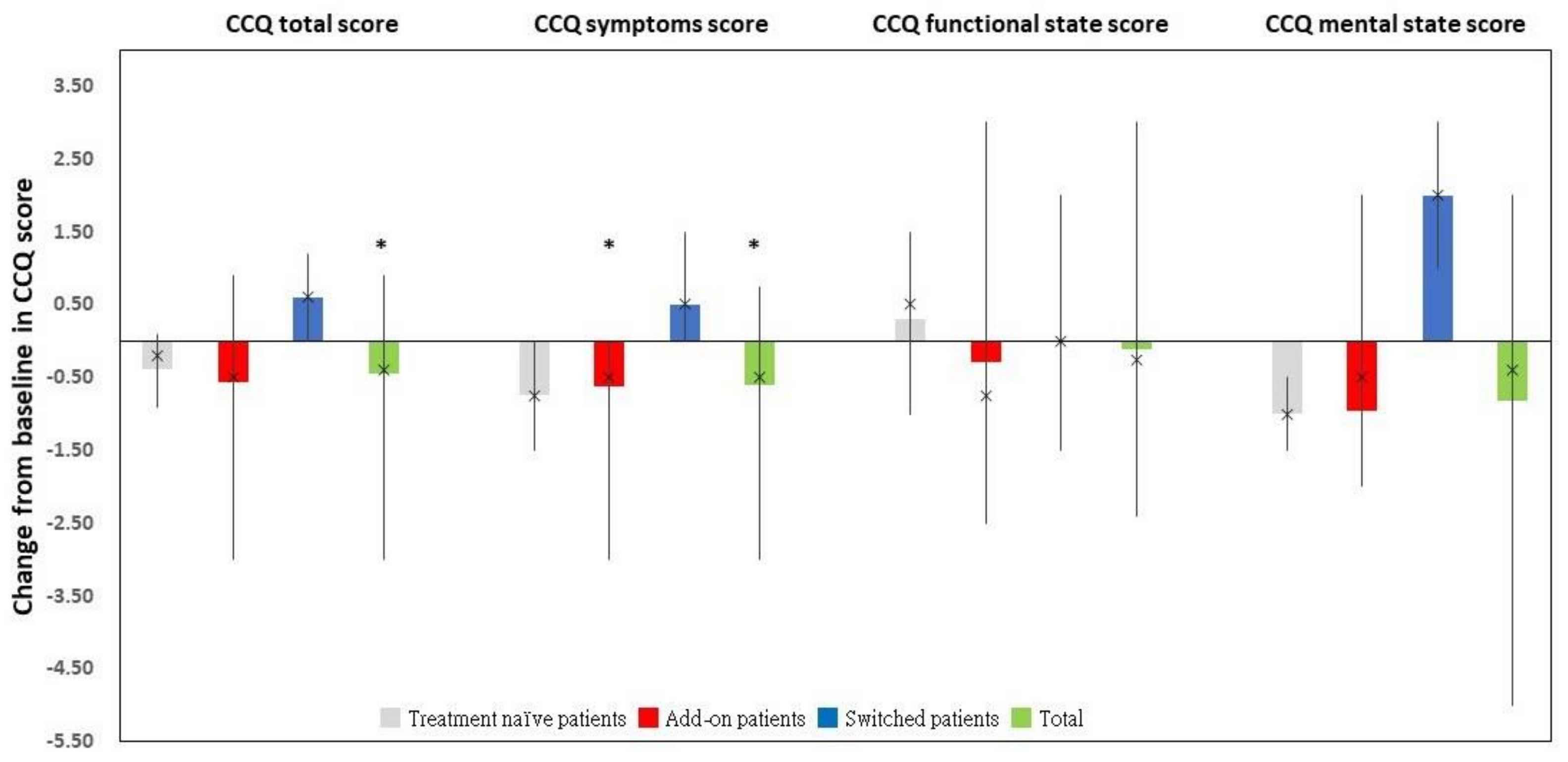The Effectiveness and Tolerability of Glycopyrronium for Patients with Chronic Obstructive Pulmonary Disease in a Clinical Setting: GLARE-Taiwan
Abstract
1. Introduction
2. Materials and Methods
2.1. Study Design and Population
2.2. Data Source and Collection
2.3. Patient Datasets/Subgroups Definition
2.4. Study Endpoints
2.5. Sample Size Calculation
2.6. Statistical Analysis
3. Results
3.1. Baseline Information
3.2. Change in CCQ Total and Domain Scores
3.3. Safety
4. Discussion
5. Conclusions
Supplementary Materials
Author Contributions
Funding
Institutional Review Board Statement
Informed Consent Statement
Data Availability Statement
Acknowledgments
Conflicts of Interest
References
- The Global Initiative for Chronic Obstructive Lung Disease. Global Strategy for the Diagnosis, Management, and Pre-Vention of Chronic Obstructive Pulmonary Disease; The Global Initiative for Chronic Obstructive Lung Disease-GOLD. 2022. Available online: https://goldcopd.org/2022-gold-reports-2/ (accessed on 1 July 2022).
- Jones, G.L. Quality of life changes over time in patients with chronic obstructive pulmonary disease. Curr. Opin. Pulm. Med. 2016, 22, 125–129. [Google Scholar] [CrossRef] [PubMed]
- Price, D.; Miravitlles, M.; Pavord, I.; Thomas, M.; Wedzicha, J.; Haughney, J.; Bichel, K.; West, D. First maintenance therapy for COPD in the UK between 2009 and 2012: A retrospective database analysis. NPJ Prim. Care Respir. Med. 2016, 26, 16061. [Google Scholar] [CrossRef] [PubMed]
- Melani, A.S. Long-acting muscarinic antagonists. Expert Rev. Clin. Pharmacol. 2015, 8, 479–501. [Google Scholar] [CrossRef] [PubMed]
- D’Urzo, A.; Ferguson, G.T.; van Noord, J.A.; Hirata, K.; Martin, C.; Horton, R.; Lu, Y.; Banerji, D.; Overend, T. Efficacy and safety of once-daily NVA237 in patients with moderate-to-severe COPD: The GLOW1 trial. Respir. Res. 2011, 12, 156. [Google Scholar] [CrossRef] [PubMed]
- Kerwin, E.; Hébert, J.; Gallagher, N.; Martin, C.; Overend, T.; Alagappan, V.K.; Lu, Y.; Banerji, D. Efficacy and safety of NVA237 versus placebo and tiotropium in patients with COPD: The GLOW2 study. Eur. Respir. J. 2012, 40, 1106–1114. [Google Scholar] [CrossRef]
- Chapman, K.R.; Beeh, K.M.; Beier, J.; Bateman, E.D.; D’Urzo, A.; Nutbrown, R.; Henley, M.; Chen, H.; Overend, T.; D’Andrea, P. A blinded evaluation of the efficacy and safety of glycopyrronium, a once-daily long-acting muscarinic antagonist, versus tiotropium, in patients with COPD: The GLOW5 study. BMC Pulm. Med. 2014, 14, 4. [Google Scholar] [CrossRef] [PubMed]
- Beeh, K.M.; Singh, D.; Di Scala, L.; Drollmann, A. Once-daily NVA237 improves exercise tolerance from the first dose in patients with COPD: The GLOW3 trial. Int. J. Chronic Obstr. Pulm. Dis. 2012, 7, 503–513. [Google Scholar] [CrossRef] [PubMed]
- Calvert, M.; Blazeby, J.; Altman, D.G.; Revicki, D.A.; Moher, D.; Brundage, M.D. Reporting of patient-reported outcomes in randomized trials: The CONSORT PRO extension. JAMA 2013, 309, 814–822. [Google Scholar] [CrossRef]
- Jones, P.W.; Harding, G.; Berry, P.; Wiklund, I.; Chen, W.H.; Kline Leidy, N. Development and first validation of the COPD Assessment Test. Eur. Respir. J. 2009, 34, 648–654. [Google Scholar] [CrossRef]
- Van der Molen, T.; Willemse, B.W.; Schokker, S.; ten Hacken, N.H.; Postma, D.S.; Juniper, E.F. Development, validity and responsiveness of the Clinical COPD Questionnaire. Health Qual. Life Outcomes 2003, 1, 13. [Google Scholar] [CrossRef]
- Lin, W.C.; Huang, T.Y.; Liu, C.Y.; Yeh, M.L.; Yu, C.H.; Hwang, S.L. Validation of the Clinical COPD Questionnaire in Taiwan. COPD J. Chronic Obstr. Pulm. Dis. 2016, 13, 360–366. [Google Scholar] [CrossRef] [PubMed]
- Wang, C.; Sun, T.; Huang, Y. Efficacy and safety of once-daily glycopyrronium in predominantly Chinese patients with moderate-to-severe chronic obstructive pulmonary disease: The GLOW7 study [Corrigendum]. Int. J. Chronic Obstr. Pulm. Dis. 2015, 10, 1513. [Google Scholar] [CrossRef]
- Reda, A.A.; Kotz, D.; Kocks, J.W.; Wesseling, G.; van Schayck, C.P. Reliability and validity of the clinical COPD questionniare and chronic respiratory questionnaire. Respir. Med. 2010, 104, 1675–1682. [Google Scholar] [CrossRef]
- Tashkin, D.P.; Rennard, S.I.; Taylor Hays, J.; Ma, W.; Marton, J.P.; Lee, T.C. Assessment Of Respiratory Symptoms, Functional And Mental Status In Subjects With Mild-To-Moderate Chronic Obstructive Pulmonary Disease (COPD) During A Randomized Controlled Smoking Cessation Trial With Varenicline. In B36. Chronic Obstructive Pulmonary Disease Non-Pharmacologic Treatments And Quality Of Life; American Thoracic Society International Conference Abstracts; American Thoracic Society: New York, NY, USA, 2010; p. A2864. [Google Scholar]
- LaForce, C.; Feldman, G.; Spangenthal, S.; Eckert, J.H.; Henley, M.; Patalano, F.; D’Andrea, P. Efficacy and safety of twice-daily glycopyrrolate in patients with stable, symptomatic COPD with moderate-to-severe airflow limitation: The GEM1 study. Int. J. Chronic Obstr. Pulm. Dis. 2016, 11, 1233–1243. [Google Scholar] [CrossRef]
- Marin, J.M.; Beeh, K.M.; Clemens, A.; Castellani, W.; Schaper, L.; Saralaya, D.; Gunstone, A.; Casamor, R.; Kostikas, K.; Aalamian-Mattheis, M. Early bronchodilator action of glycopyrronium versus tiotropium in moderate-to-severe COPD patients: A cross-over blinded randomized study (Symptoms and Pulmonary function in the moRnING). Int. J. Chronic Obstr. Pulm. Dis. 2016, 11, 1425–1434. [Google Scholar] [CrossRef]
- D’Urzo, A.; Bader, G.; Shen, S.; Goyal, P.; Altman, P. Comparison of glycopyrronium versus tiotropium on the time to clinically important deteriorations in patients with COPD: A post-hoc analysis of randomized trials. NPJ Prim. Care Respir. Med. 2018, 28, 18. [Google Scholar] [CrossRef] [PubMed]




| Characteristics | Total (n = 110) |
|---|---|
| Age (years) | |
| Mean ± SD | 71.25 ± 10.60 |
| Median | 71.55 |
| Min-Max | 34–95 |
| <40 years | 2 (1.82%) |
| 40–64 years | 25 (22.73%) |
| 65–74 years | 38 (34.55%) |
| ≥75 years | 45 (40.91%) |
| Male | 101 (91.82) |
| Asian | 110 (100%) |
| BMI (kg/m2) | |
| Mean ± SD | 24.70 ± 4.38 |
| Median | 24.40 |
| Min-Max | 14.50–40.70 |
| Smoking status | |
| Non-smoker | 13 (11.82%) |
| Ex-smoker | 68 (61.82%) |
| Current smoker | 29 (26.36%) |
| Airflow limitation | |
| GOLD 1 | 7 (6.36%) |
| GOLD 2 | 53 (48.18%) |
| GOLD 3 | 41 (37.27%) |
| GOLD 4 | 9 (8.18%) |
| COPD duration (years) | |
| Mean ± SD | 3.84 ± 4.17 |
| History of moderate-to-severe COPD exacerbations within one year | |
| Mean ± SD | 0.44 ± 0.92 |
| 0 | 80 (73.39%) |
| 1 | 19 (17.43%) |
| 2 | 5 (4.59%) |
| 3 | 1 (0.92%) |
| 4 | 4 (3.67%) |
| Missing | 1 (0.91%) |
| History of severe exacerbations within one year | |
| Mean ± SD | 0.22 ± 0.58 |
| 0 | 91 (83.49%) |
| 1 | 14 (12.84%) |
| 2 | 3 (2.75%) |
| 4 | 1 (0.92%) |
| Missing | 1 (0.92%) |
| Inhaled COPD maintenance medication | |
| None | 9 (8.18%) |
| LAMA alone | 35 (31.82%) |
| Tiotropium | 35 (31.82%) |
| LABA alone | 49 (44.55%) |
| Indacaterol | 36 (32.73%) |
| Salmeterol | 13 (11.82%) |
| ICS/LABA | 17 (15.45%) |
| Salmeterol/Fluticasone | 9 (8.18%) |
| Budesonide/Formoterol | 6 (5.45%) |
| Formoterol/Beclomethasone | 2 (1.82%) |
| Oral COPD maintenance medication | |
| Prednisolone | 4 (3.64%) |
| Methylxanthines | 53 (48.18%) |
| Roflumilast | 1 (0.91%) |
| Subgroup | |
| Treatment-naïve | 9 (8.18%) |
| Add-on | 75 (68.18%) |
| Switched | 26 (23.64%) |
| Comorbidity | |
| Any | 37 (33.64%) |
| Hypertension | 16 (14.55%) |
| Benign prostatic hyperplasia | 13 (11.82%) |
| Allergic rhinitis | 10 (9.09%) |
| Diabetes mellitus | 10 (9.09%) |
| Coronary artery disease | 9 (8.18%) |
| Asthma | 7 (6.36%) |
| Gastroesophageal reflux disease | 7 (6.36%) |
| Chronic renal failure | 6 (5.45%) |
| Hyperlipidemia | 6 (5.45%) |
| Total (n = 110) | |
|---|---|
| Patients with any AE | 58 (52.73%) |
| Common AEs (occurring in >3.0% of participants) | |
| COPD worsening | 9 (8.18%) |
| Constipation | 5 (4.55%) |
| Dizziness | 5 (4.55%) |
| Edema | 5 (4.55%) |
| Urinary tract infection | 5 (4.55%) |
| Dyspepsia | 4 (3.64%) |
| Upper respiratory tract infection | 4 (3.64%) |
| Death | 1 (0.90%) |
| Discontinuation due to AE | 3 (2.73%) |
Publisher’s Note: MDPI stays neutral with regard to jurisdictional claims in published maps and institutional affiliations. |
© 2022 by the authors. Licensee MDPI, Basel, Switzerland. This article is an open access article distributed under the terms and conditions of the Creative Commons Attribution (CC BY) license (https://creativecommons.org/licenses/by/4.0/).
Share and Cite
Huang, W.-C.; Lin, S.-H.; Hang, L.-W.; Lin, C.-H.; Hsu, J.-Y. The Effectiveness and Tolerability of Glycopyrronium for Patients with Chronic Obstructive Pulmonary Disease in a Clinical Setting: GLARE-Taiwan. J. Clin. Med. 2022, 11, 6210. https://doi.org/10.3390/jcm11206210
Huang W-C, Lin S-H, Hang L-W, Lin C-H, Hsu J-Y. The Effectiveness and Tolerability of Glycopyrronium for Patients with Chronic Obstructive Pulmonary Disease in a Clinical Setting: GLARE-Taiwan. Journal of Clinical Medicine. 2022; 11(20):6210. https://doi.org/10.3390/jcm11206210
Chicago/Turabian StyleHuang, Wei-Chang, Sheng-Hao Lin, Liang-Wen Hang, Ching-Hsiung Lin, and Jeng-Yuan Hsu. 2022. "The Effectiveness and Tolerability of Glycopyrronium for Patients with Chronic Obstructive Pulmonary Disease in a Clinical Setting: GLARE-Taiwan" Journal of Clinical Medicine 11, no. 20: 6210. https://doi.org/10.3390/jcm11206210
APA StyleHuang, W.-C., Lin, S.-H., Hang, L.-W., Lin, C.-H., & Hsu, J.-Y. (2022). The Effectiveness and Tolerability of Glycopyrronium for Patients with Chronic Obstructive Pulmonary Disease in a Clinical Setting: GLARE-Taiwan. Journal of Clinical Medicine, 11(20), 6210. https://doi.org/10.3390/jcm11206210






